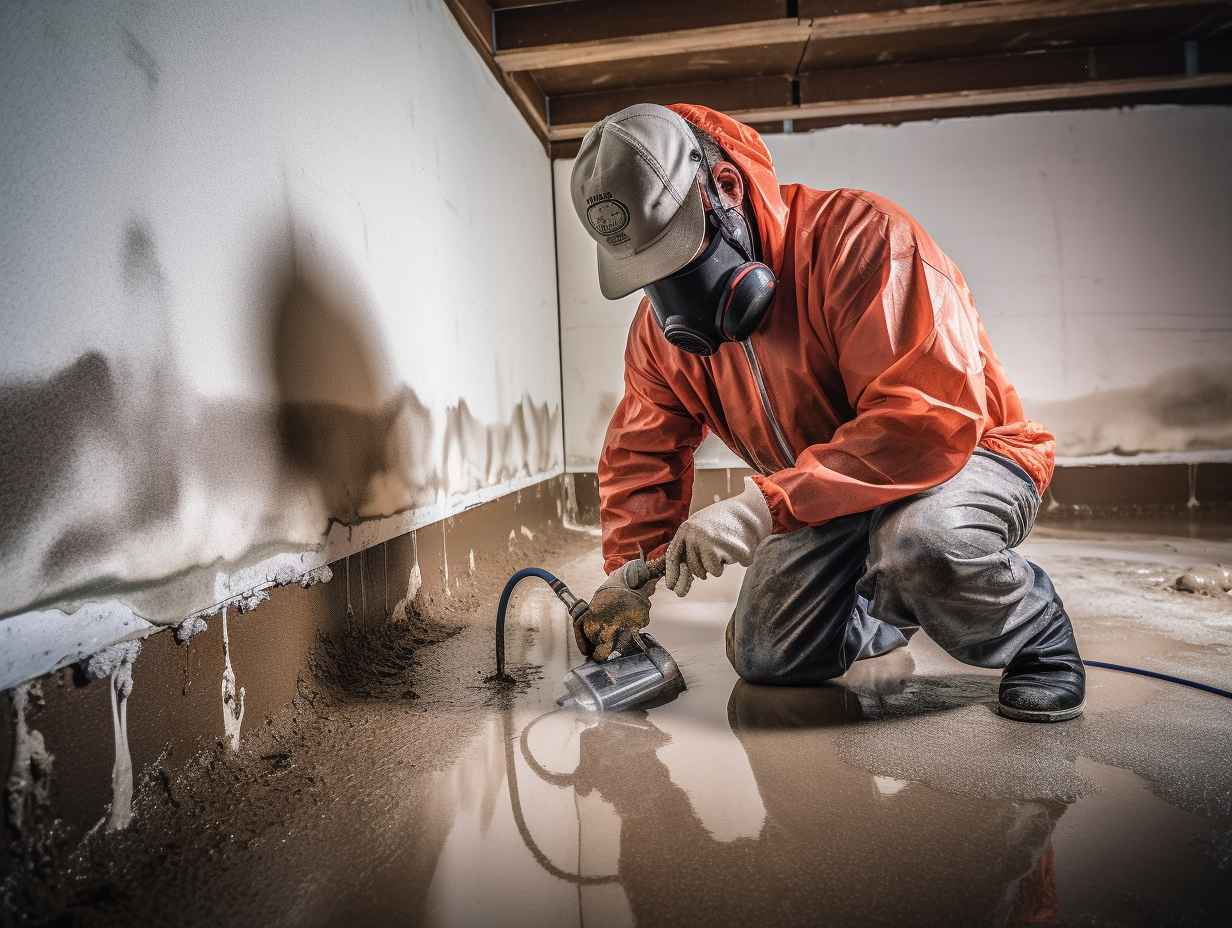
Sealing Out Moisture: Waterproofing Secrets
Table Of Contents
- Understanding the Risks of Moisture Damage
- Choosing the Right Waterproofing Materials
- Examining the Different Waterproofing Techniques
- Waterproofing Your Roof: Tips and Tricks
- Protecting Your Basement from Water Damage
- Waterproofing Your Bathroom and Kitchen
- Preventing Water Damage in Your Garden and Yard
- Maintaining Your Waterproofing System
- Hiring a Professional Waterproofing Contractor
- Future Trends in Waterproofing Technology
- Frequently Asked Questions
- Conclusion

Did you know that water damage is the second most common insurance claim in the United States? It’s a staggering statistic, and it’s one that should make you sit up and take notice. Whether you own a home or run a business, moisture can wreak havoc on your property, causing extensive damage and costly repairs. The good news is that there are plenty of waterproofing secrets that can help keep your property safe and dry.
In this article, we’ll explore everything you need to know about sealing out moisture. From understanding the risks of water damage to choosing the right materials and techniques for waterproofing your property, we’ve got you covered. We’ll share tips and tricks for protecting your roof, basement, garden, and yard from moisture damage, as well as advice for maintaining your waterproofing system. Plus, we’ll take a look at future trends in waterproofing technology so you can stay ahead of the curve. So let’s dive in!
Understanding the Risks of Moisture Damage

You don’t want to risk your hard-earned money by ignoring the dangers of moisture damage, do you? Common causes of moisture damage include leaks from plumbing fixtures, roof problems, and poor ventilation. Other sources of moisture include condensation and humidity levels that are too high.
Fortunately, there are many prevention methods that can help protect your property from moisture damage. Regular inspections can help identify potential problem areas before they become major issues. It’s also important to address any leaks or water-related problems as soon as possible to prevent further damage. Additionally, proper ventilation can help control humidity levels and reduce the risk of mold growth. By taking these steps, you can effectively seal out moisture and protect your investment for years to come.
Choosing the Right Waterproofing Materials
When it comes to keeping your basement dry, it’s important to select the appropriate materials that will effectively repel any unwanted water. With so many options available on the market, choosing the right waterproofing materials can be overwhelming. To ease your selection process, here are three factors to consider when comparing waterproofing materials:
-
Top waterproofing brands: Look for reputable brands with a proven track record of producing reliable waterproofing products. Research customer reviews and ratings to ensure you’re investing in a quality product.
-
Material composition: Different types of waterproofing materials have varying levels of durability and effectiveness. Some common options include concrete sealers, epoxy coatings, and polyurethane injections.
-
Application method: Consider how easy or difficult it is to apply each type of material before making a decision. Some may require professional installation while others can be applied by homeowners themselves with relative ease.
By taking these factors into account and comparing various waterproofing materials, you’ll be well-equipped to choose the best option for your specific needs and budget.
Examining the Different Waterproofing Techniques

Looking to protect your basement from unwanted water? Let’s explore the different techniques available for waterproofing. There are various approaches you can take, each with its advantages and disadvantages. To help you decide which technique is right for you, let’s examine them in more detail.
First, let’s talk about sealants. Sealants are a common waterproofing method and come in two forms: liquid and sheet. Liquid sealants are applied like paint, while sheet sealants come in rolls that are cut to fit the required area. They both work by creating a barrier between the surface and any moisture that may be present. While easy to apply, they may not always be suitable for large or uneven surfaces as they can crack over time due to changes in temperature or structural movement. Additionally, some types of sealants emit harmful fumes during application and curing, so it’s important to choose one that is safe for indoor use if necessary.
| Types of Sealants | Advantages | Disadvantages |
|---|---|---|
| Liquid | Easy application; Good coverage; Suitable for small areas | Can crack over time; May emit fumes |
| Sheet | Durable; Good coverage; Suitable for larger areas | Difficult to install on uneven surfaces |
Another technique worth considering is waterproofing for electronics. This method involves coating electronic devices with a protective layer that prevents water from penetrating their delicate components while still allowing them to function normally. This technique is particularly useful in industrial settings where sensitive equipment must remain operational even when exposed to harsh weather conditions or damp environments.
| Waterproofing for Electronics | Advantages | Disadvantages |
|---|---|---|
| Protects sensitive equipment from water damage; Allows normal functioning of electronics under wet conditions | Costly; Requires specialized knowledge and tools |
By understanding these techniques’ pros and cons, you’ll be better equipped to choose the right waterproofing method for your needs. Keep in mind that some techniques may be more suitable than others depending on your budget, the surface you need to waterproof and how much moisture it is exposed to.
Waterproofing Your Roof: Tips and Tricks
To effectively protect your home from water damage, it is important to employ various techniques, including proper maintenance and repair of your roof. Your roof is one of the most vulnerable parts of your home when it comes to water damage. That’s why it’s crucial to ensure that it’s waterproofed properly.
One way to do this is by using high-quality roofing materials such as asphalt shingles, metal roofing, or rubber membranes. Another option is to apply a DIY waterproofing solution on top of your existing roof. Some popular methods include applying a sealant or coating, installing a waterproof membrane layer, or using a spray-on foam insulation system. Whatever method you choose, make sure that you follow the manufacturer’s instructions carefully and use quality materials for best results. With proper waterproofing in place, you can rest easy knowing that your home is protected from water damage caused by leaks and inclement weather conditions.
Protecting Your Basement from Water Damage

Don’t let water damage ruin your home’s foundation - safeguard your basement with these easy tips! When it comes to protecting your basement from water damage, there are several basement waterproofing solutions you can try. One of the most effective ways is to hire professionals who specialize in waterproofing basements. However, if you’re on a budget and want to save money, there are also many DIY waterproofing techniques that you can do yourself.
One popular DIY technique is using waterproof coatings and sealants. These products come in different forms such as sprays, paints, or epoxies that can be applied directly onto the walls and floor of your basement. Another option is installing drainage systems like French drains or sump pumps which helps divert excess water away from your home’s foundation. Lastly, sealing any cracks or gaps in your foundation can prevent water seepage and make sure that no moisture can enter through those openings. By taking these simple steps, you can have peace of mind knowing that you’ve protected your basement from potential water damage problems.
| Basement Waterproofing Solutions | DIY Waterproofing Techniques | Professional Help |
|---|---|---|
| Sealant coatings | Installing drainage systems (French drains/sump pumps) | Hiring professional waterproofers |
| Sealing cracks/gaps | Epoxy injections | Using specialized tools/equipment |
| Water-resistant paint | Landscaping solutions | Conducting inspections/evaluations |
| Dehumidifiers | Re-grading soil around house |
Waterproofing Your Bathroom and Kitchen
Water damage can wreak havoc on your home, but with a few simple steps, you can ensure that your bathroom and kitchen remain protected from potential leaks and spills like a fortress. The first step is to waterproof the tiles in your bathroom and kitchen. This will prevent water from seeping through the tiles and damaging the subfloor or walls. You can use a waterproofing membrane or coating to achieve this.
The second step is to seal the grout joints between the tiles. Grout is porous and can absorb water, which can lead to mold growth or even structural damage over time. By sealing the grout joints, you create a barrier that prevents moisture from penetrating them. You can use a silicone-based sealer for this purpose. It’s important to note that these steps should be taken during construction or renovation of your bathroom and kitchen, but if you haven’t done so yet, it’s never too late to start!
Preventing Water Damage in Your Garden and Yard

Now that you’ve learned how to waterproof your bathroom and kitchen, it’s time to turn your attention to the outdoors. Your garden and yard are just as vulnerable to water damage, but with the right precautions, you can prevent it from happening. With heavy rainfalls and unpredictable weather patterns becoming more common, it’s important to take measures to protect your outdoor space from moisture.
One way to do this is through rainwater harvesting. By collecting rainwater in barrels or other containers, you can reduce the amount of runoff on your property and use the collected water for irrigation purposes. Additionally, incorporating proper drainage systems into your landscaping design will help redirect any excess water away from structures and prevent erosion. Don’t let moisture ruin all of your hard work in creating a beautiful outdoor space - take control with these preventative measures.
Maintaining Your Waterproofing System
Keeping up with maintenance is key to ensuring your waterproof system continues to work effectively and keeps your home safe from water damage. It is important to create a maintenance routine that involves regular check-ups and repairs, as well as cleaning out any debris or dirt that may have accumulated in the area.
To prevent leaks, it is recommended that you inspect your waterproofing system at least once a year. This will help you identify any potential problems before they become major issues. Additionally, keep an eye out for any cracks or gaps that may have formed in the sealant and promptly address them. By taking these steps, you can rest assured that your waterproofing system will continue to protect your home for years to come.
| Maintenance Task | Frequency | Importance |
|---|---|---|
| Cleaning gutters | Twice/year | High |
| Inspecting seals | Annually | High |
| Checking sump pump | Annually | Medium |
The above table provides some examples of tasks you should include in your maintenance routine along with their frequency and importance level. Remember, maintaining your waterproofing system doesn’t have to be difficult or time-consuming; by incorporating these simple tasks into your routine, you can ensure the longevity of your system and prevent costly water damage in the future.
Hiring a Professional Waterproofing Contractor

If you want to ensure your home is protected from potential water damage, you need to hire a professional waterproofing contractor who can provide you with expert guidance and support. While it may seem like an added expense, hiring a professional is actually more cost-effective in the long run. Professionals have the expertise and experience necessary to identify potential problem areas before they become major issues that require costly repairs.
In addition to being cost-effective, there are many benefits to hiring a professional waterproofing contractor. For one, professionals have access to high-quality materials and equipment that will provide better protection for your home. They also understand the different types of waterproofing systems available and can help you choose the one that best fits your needs and budget. Finally, by hiring a professional contractor, you can rest easy knowing that your home is in good hands and that any potential water damage will be prevented.
Future Trends in Waterproofing Technology
Oh boy, it looks like waterproofing technology is advancing faster than you can say ‘leaky basement.’ With all the fancy gadgets and gizmos on the market, it seems like pretty soon our homes will be able to withstand a tsunami. One of the emerging innovations in waterproofing technology is the use of nanotechnology. This involves adding tiny particles to sealants that can penetrate even the smallest cracks and crevices, making them completely impermeable to water.
Another trend in waterproofing technology is an increased focus on sustainability practices. More and more homeowners are looking for eco-friendly solutions that not only protect their homes but also reduce their impact on the environment. Some companies are now offering plant-based or biodegradable sealants that are just as effective as traditional ones while being much less harmful to both humans and wildlife. As we continue to face more extreme weather conditions due to climate change, these sustainable solutions will become even more important in ensuring that our homes stay safe and dry.
Frequently Asked Questions
Are there any natural waterproofing materials available?
Looking for a natural waterproofing alternative? Beeswax has benefits including sustainability and low toxicity. Compared to synthetic options, it may be less effective but also less costly.
How long does it typically take to waterproof a basement or bathroom?
Waterproofing your basement or bathroom can take anywhere from a few days to several weeks depending on the factors affecting the timeline. The cost comparison of professional vs. DIY waterproofing will also play a role in determining how long it takes to complete the project.
Can waterproofing be done on a DIY basis, or should I always hire a professional?
Yes, you can attempt DIY waterproofing with some tips like using waterproof paint and sealing cracks. However, for more complex issues or if you want a guarantee, it’s always best to hire professional waterproofing services.
What are the most common mistakes people make when attempting to waterproof their home?
You’ve heard the saying, “measure twice, cut once.”When it comes to waterproofing your home, don’t rush the process. Common mistakes include inadequate preparation and using subpar materials. Essential techniques include proper drainage and sealing all cracks and joints.
Is there a specific type of waterproofing that works best in areas with high humidity?
When dealing with high humidity, the best waterproofing techniques involve using materials that are specifically designed to withstand moisture. Look for products labeled as “moisture-resistant”or “waterproof.”
Conclusion
Now that you have a good understanding of the risks of moisture damage and the different waterproofing techniques available, it is time to take action. Choosing the right materials and hiring a professional contractor can make all the difference in protecting your home from water damage.
As you maintain your waterproofing system, remember that prevention is key. Taking small steps like cleaning gutters and downspouts regularly or adding landscaping features to prevent runoff can go a long way in keeping your home safe from water damage. And as technology continues to evolve, keep an eye out for new trends in waterproofing that could offer even more protection for your home.
By sealing out moisture with proper waterproofing techniques, you can rest easy knowing that your home is protected from the damaging effects of water. So don’t wait until it’s too late – take action now and ensure that your home stays dry and safe for years to come.
Disclaimer: Some information is provided through AI. Users should always conduct their own research and consult with qualified professionals before making any decisions.Affiliate information declaration: We may earn revenue from the products referred on this page and participate in affiliate programs.


